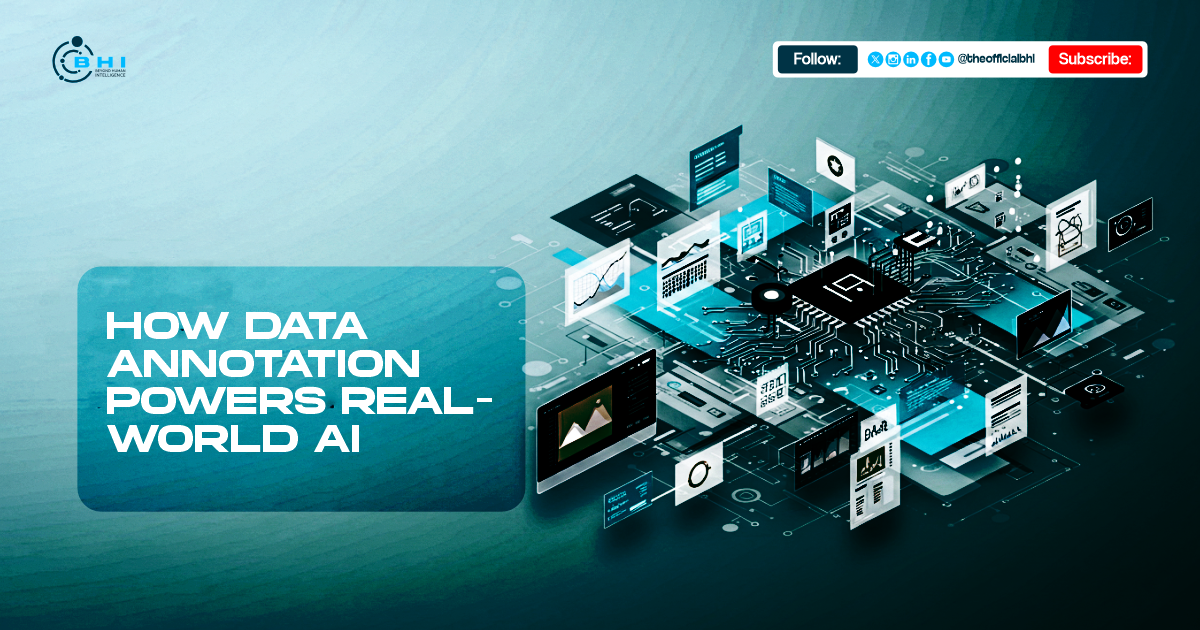Ikeja, Lagos, Nigeria

Before your model learns anything, your data must be labelled with precision. That’s the transformative role of data annotation; it converts raw information into actionable intelligence.
💡 Introduction
In today’s fast-moving AI landscape, algorithms get the glory, but annotated data does the heavy lifting.
Whether you’re diagnosing disease, predicting customer behaviour, or powering autonomous systems, data annotation is the foundation that makes AI possible. And yet, it remains one of the most misunderstood and underleveraged parts of the machine learning pipeline.
This post explores five high-impact ways annotation is driving innovation across sectors from healthcare to finance, helping you understand where annotation adds value, and how to make it a competitive advantage in your own AI roadmap.
🚑1. Healthcare: Diagnosing with Precision Through Annotated Medical Data
In healthcare, AI systems are trained to interpret medical scans, clinical notes, and patient records, but only if experts annotate that data.
Example: A radiology AI model trained to detect early-stage tumours requires thousands of MRI or CT scans, each labelled by medical professionals to identify features like tumour size, location, and density.
Annotation Types:
- Medical image segmentation (e.g. identifying tumours or lesions)
- NLP for EHRs (Electronic Health Records)
- Audio transcription from telemedicine sessions
🔗 Real-world reference: RSNA AI Resources provides public datasets for medical imaging AI projects.
Why it matters: Studies show that model accuracy can drop by over 20% when annotated datasets lack domain-specific expertise or consistency.
🌿 2. Agriculture: Smarter Farming With Annotated Drone and Satellite Imagery
AI is transforming modern agriculture from optimising irrigation to detecting disease outbreaks. But image-based models used in precision farming rely on annotated aerial footage of crops and terrain.
Example: A drone captures a field with early signs of blight. Only annotated data can help AI distinguish between healthy plants and those showing symptoms under different lighting and soil conditions.
Annotation Types:
- Image classification (healthy vs. diseased crops)
- Object detection (pests, weeds, irrigation lines)
- Time-series labelling (weather, soil moisture, crop cycles)
🔗 Learn more via NASA’s Earth Science & Agriculture Programs.
Why it matters: Precision annotations can increase crop monitoring accuracy and yield predictions, saving millions for agribusinesses worldwide.
🛍️ 3. Retail & E-commerce: Powering Visual Search and Personalisation
In retail, personalisation is king. AI systems must understand product details, customer preferences, and sentiment trends to drive conversions. That requires annotated datasets across multiple data types.
Example: A fashion retailer using AI to recommend products needs annotated product images (colour, category, style), as well as labelled customer reviews to assess sentiment and product relevance.
Annotation Types:
- Image tagging (colour, shape, material)
- Text sentiment analysis
- Audio annotation for chatbot training
🔗 See this in action with Google Cloud’s Retail AI case studies.
Why it matters: High-quality annotation can boost recommendation accuracy and increase revenue through more relevant customer experiences.
💼 4. Finance: Document Processing and Anti-Fraud AI
In finance, AI is used to process millions of documents, monitor for fraud, and automate compliance tasks. To perform well, these systems need datasets annotated for both structure and meaning.
Example: Annotating scanned IDs and transaction records enables AI to automate Know Your Customer (KYC) checks, cutting onboarding time and preventing fraud.
Annotation Types:
- Named Entity Recognition (e.g. names, dates, amounts)
- Document layout analysis (invoices, IDs, bank statements)
- Audio/text sentiment tagging for fraud detection
🔗 Read more via FINRA’s AI and Automation Report.
Why it matters: Well-annotated datasets enable automation of time-intensive tasks and ensure regulatory compliance with confidence.
🚘 5. Autonomous Vehicles: Teaching Machines to Navigate Safely
Autonomous vehicles rely on complex AI systems that need frame-by-frame annotation of video, lidar, and sensor data to make driving decisions.
Example: A self-driving system must accurately detect pedestrians, road signs, and lane markings from various angles and lighting conditions. Without annotated data, even the most advanced models fail to perform safely.
Annotation Types:
- 2D/3D bounding boxes for objects (cars, people, signs)
- Semantic segmentation for roads, sidewalks, and hazards
- Point cloud labelling from lidar sensors
🔗 Explore Waymo’s Safety Report for insight into how annotated data powers their autonomous systems.
Why it matters: In real-time driving environments, 1% improvement in detection accuracy can mean the difference between safety and disaster.
What These Use Cases Share in Common
No matter the industry, annotated data must be:
- Accurate — errors in annotation lead to biased or broken models
- Scalable — volume matters in deep learning success
- Tailored — industry-specific annotation types make all the difference
- Consistently validated with QA systems and expert reviews
At Beyond Human Intelligence, we support complex annotation workflows across text, image, video, and audio—built to scale and guided by domain expertise.
🧩 Final Thoughts: The Backbone of Real-World AI
Modern AI breakthroughs are not powered by algorithms alone; the quality and precision of annotated data drive them. Models only perform as well as the information they’re trained on.
That’s why forward-thinking teams don’t treat annotation as an afterthought. They treat it as a strategic layer of the AI stack.
✅ Ready to Build Smarter AI?
Whether you’re launching a new product or scaling an existing model, let’s help you structure the data that drives it.
🚀 Book a free annotation consultation with BHI
📂 Request a sample annotation workflow tailored to your use case
🔗 Follow BHI on LinkedIn for weekly insights
